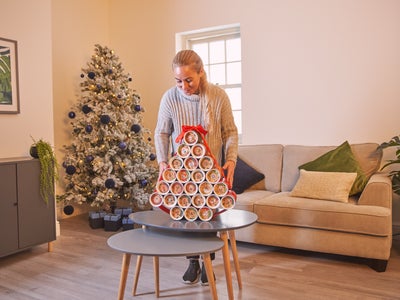Space Saving Christmas Trees
- 40mm screws
- Washers
- Paper clips
- Soudal super glue & activator
- Interior wood paint
- All purpose filler
- x2 2.4m Timber lengths 22 x 47mm
- Christmas tree lights
- Baubles
If space in your home is at a premium or you are looking for a more sustainable way to display your decorations, why not try something different and make your very own Christmas tree?
Free standing Christmas tree

Our freestanding frame tree is a sleek, modern alternative to a reusable plastic tree, Plus, it’s an easy task for anyone with basic DIY knowledge and the right tools for the job.
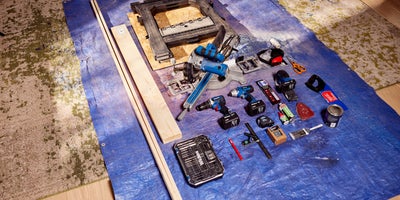
Before you begin, create a safe working space by removing any obstacles such as tables, chairs, or decorations.
Lay tarpaulin out in your working space then place your materials and tools down, so you can double check you have everything you need.
Top tip: When purchasing your timber, look down from the top to check the wood hasn’t warped as this could potentially change the angles for your timber joints.
We have designed this tree to have a height of 1200mm with a width of 805mm to create the shape of an isosceles triangle.
All angles are relevant to these measurements, if you would like to make your tree smaller or larger – then this is a great time to re-familiarise yourself with your GCSE trigonometry knowledge to work out the angles, as these will be different if you increase the width of the base.
Both side pieces of timber will have a 50.5-degree angle at the top and a 19.5-degree angle at the bottom.
The bottom piece requires a 19.5 degree cut at both ends, so it’ll sit flush within the two edges.
Setup your mitre saw on your workbench.
Top tip: Before using your mitre saw, ensure it is secured to your workbench with screws and washers to prevent it slipping.
Use a set square to measure a 50.5-degree angle at the top end of your timber and make a pencil mark.

Load timber onto the mitre saw.
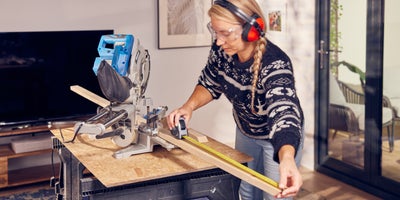
Measure 1234mm from the end, mark your measurement on the face of the timber with a pencil.
Cut the timber at 1234mm with a 50.5-degree angle cut at the top.
At the bottom of your 1234mm timber piece, use a set square to measure 19.5-degree angle and cut it to shape.
Measure 1262mm from the cut end of your timber and mark your measurement on to the face of timber using a pencil and cut it to size.
Then use a set square to mark your 50.5-degree angle at the top of the cut and cut it to shape.
Once you’ve done that, use a set square to measure 19.5-degree angle on the bottom and cut it to shape.

With your two sides cut to size, it’s time to measure and cut the bottom piece.
Measure 805mm and make your pencil markings, flip the timber to transpose your measurement onto the side of the timber. Cut the timber to create an 805mm length.
Use a set square to measure and mark a 19.5-degree angle at both ends of the 805mm cut
Cut both ends at a 19.5-degree angle, which will mean it forms a flush triangle shape with your other timber cuts (1234mm & 1262mm)
With your frame pieces cut to size, it’s time to move onto your base piece

Load your base timber onto the mitre saw, measure 537mm from the end, make a pencil marking and cut it to size.

To make all your cuts look their best and create a smooth finish, use a corner sander to smooth out the faces of your cut timber. Make sure to avoid rounding off your corners.
With all your cuts made, it’s time to form your timber triangle frame. If your workbench isn’t big enough, you can do the following steps on your laid-out tarpaulin.

Lay your cut timber into the shape of an isosceles triangle, so you can check your angles have been cut precisely. Once you’ve checked they line up, you’re ready to bond them together.
Top tip: When bonding together your pieces of timber, place a piece of paper beneath the mitre joint of the wood, so that it doesn’t stick to your workbench or tarpaulin.

Prepare your combi drill by attaching a 3/4mm wood drill bit.
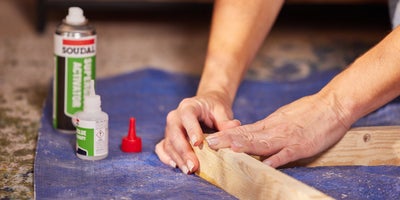
Starting from the top joint, spray super glue applicator onto the face of the angle on the 1262mm piece, then apply super glue to the angled end on the 1234mm piece and hold for 10 seconds so that it sticks together.
Move down to your base timber and spray applicator onto the face of the angle on the 1234mm piece, then apply glue to the angled end of the base piece and hold them together for 10 seconds.
Now move to the other side of the base, spray applicator onto the face of the angle on the 1262mm piece and apply glue to the other angled end on the base and hold them together for 10 seconds.
With your timber bonded into an isosceles triangle shape, it’s time to secure the joint ends together with screws.
Starting from the top of your timber triangle frame, drill a pilot hole into the longest side (1262mm) and into the shortest side (1234mm).
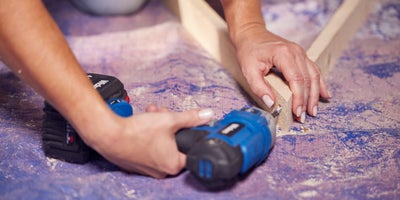
Drill a pilot hole through the face of the longest side (1262mm) and into the bottom piece.
Then drill a pilot hole into the face of the shortest side (1234mm) and into the bottom piece on the other side.
Now attach the 10mm countersink drill bit to your combi drill and drill into each of the pilot holes you’ve just made.
Once you’ve done that, drill screws into the pilot holes to secure the timber pieces together.
With your timber isosceles triangle formed, it’s time to secure it to the base block of timber.
Stand the timber triangle on top of the base block and use a digital angle rule to check that the angle at the top of the timber triangle reads 50 degrees before continuing.
Top tip: To get the most accurate reading, open the digital angle rule to 180 degrees then set it to zero before lining up to measure your angles.
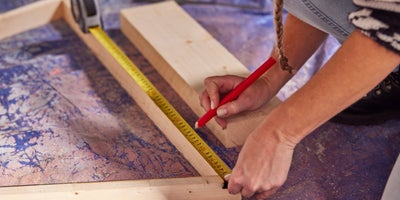
Use a tape measure to measure the base of the timber triangle, then minus this figure against the length of the base block and divide this result by 2 – this will provide you with your overhang measurement for either side of the base block. (805mm – 537mm / 2 = 134mm)
Mark the centre of the base of the timber triangle frame, then measure from the centre point to the edge of the base block. Divide this figure by two, which will provide you with your equally spaced screw holes. *You can add extra screws if you wish*

Drill pilot holes into the markings you’ve made by drilling into the face of the inside of the timber triangle frame and into the timber base.
Follow this up by using the countersink on your pilot holes, before securing the triangle timber frame to your timber base with 40mm screws.
With the timber triangle frame secured to the timber base, bring your all-purpose filler over ready to cover the screws and where the timber joints meet.
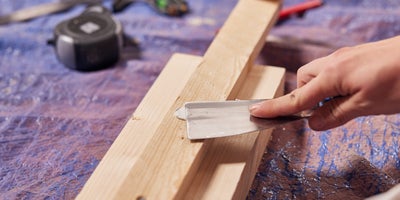
Scoop a small amount of filler onto a filling knife and spread it evenly over each of the screws and where the timber joints meet.
Now it’s time to determine where you’ll hang your lights, if you haven’t got access to lights, then we recommend using string to hang decorations like baubles and light tinsel.

Hold the end of the guide string to the top of the triangle, wrap it round and stick a piece of masking tape over the end so that it stays put while you’re bringing the triangle and base down to the floor.
Mark every wrap of the string with a pencil on the back of the frame, ready to cut your grooves.
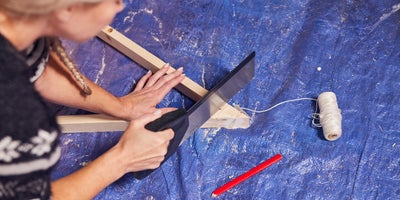
Use your tenon saw to cut the grooves: First cut a straight guideline, then saw from an angle on either side so that the middle comes away to create a groove.
Run your string around the triangle frame to see how it sits within the grooves. Once you’re happy, remove the guide string.

Clean up your applied filler by sanding it down with a corner sander.

Bring your paint and paintbrush over to your workspace, put painting gloves on if you wish to, then apply a generous amount of paint to the timber frame and base and spread evenly. Refer to your paint tin to find out how long you need to wait for your paint to dry.
Fold out your paper clips ready to hook your baubles onto.
Once your paint has dried, unpack your Christmas lights (or string if you don’t have any) and wrap them into the grooves.

Customise your tree to suit the aesthetic of the room you’ve placed it in using festive, colour co-ordinating tinsel and baubles.

And there you have it. A frame-style Christmas tree.
Wall mounted Christmas tree
Another option if you’re squeezed for space at home or you’re looking to do something different when it comes to your tree this Christmas is creating your very own hanging Christmas tree.
Not only does it take less time than transporting and dressing a natural tree, but it’s also an easy and rewarding build that anyone can do with the right guidance and tools for the job.
Before you start, secure your mitre saw to a work bench, so that you’re ready to cut your timber lengths.

Cut 60mm off each length to create the triangular shape of the tree.
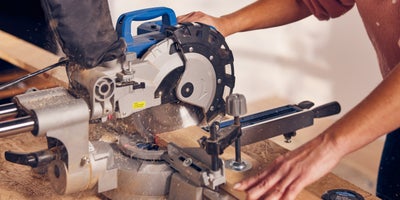
You should end up with 11 cut pieces with the following sizes: 700mm, 640mm, 580mm, 520mm, 460mm, 400mm, 340mm, 280mm, 220mm, 160mm, 100mm.
These cuts will come together to form a tree with a height of 1720mm and a 70mm gap between each piece, you can change the size of the gap to suit your personal preference. Or if you wish to make it smaller, take a few pieces away starting from the bottom cuts.
With each piece of timber, use your set square to measure 47mm up from bottom edge and mark it with pencil.

Then use your set square from the side and measure 15mm and make a pencil mark.
Now cross the marks you’ve made, this will give you your screw position.
Repeat steps 3-5 on the other end of your piece of timber.
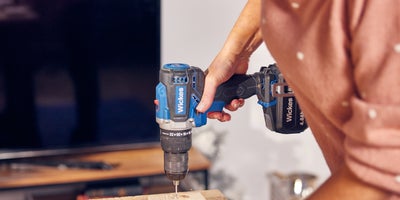
Drill a 4mm pilot hole into your markings, then follow that up with a countersink.

Once you’ve done that, you can then paint the pieces of timber.
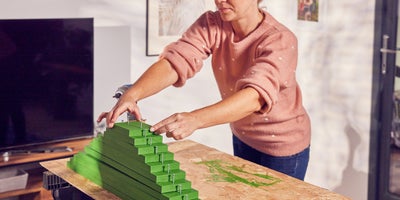
Repeat steps 3-8 for each piece of timber.
You’re now ready to fix each piece to the wall using your command strips. First bring your 600mm spirit level, tape measure and pencil over to the area where you’d like to hang up your tree.

Measure 690mm up from the right of the wall and mark it with a pencil, then measure 40mm up from the floor and mark it. Use a spirit level to draw a level line and connect your guide markings. The bottom piece will sit on this line.
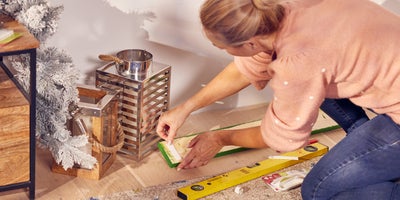
Attach command strips to the back edges of the bottom piece, then place it on your level line and push against the wall.

From the middle top of your fitted bottom piece, use a tape measure to measure 70mm up and make a mark, this is where the bottom of your next piece will sit.
Use a spirit level draw a straight line across your mark.

Attach command strips to the back edges of the next piece, then place on your level line and push against the wall.
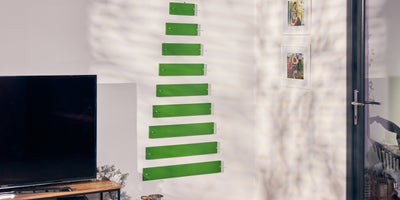
Repeat this process until all the pieces of timber are attached to the wall to create your hung Christmas tree.

With the timber tree attached to your wall, it’s time to dress it up. Use the screws on each piece of timber to wrap and hang your Christmas lights, then you can use the wires on the lights to hang your baubles.

